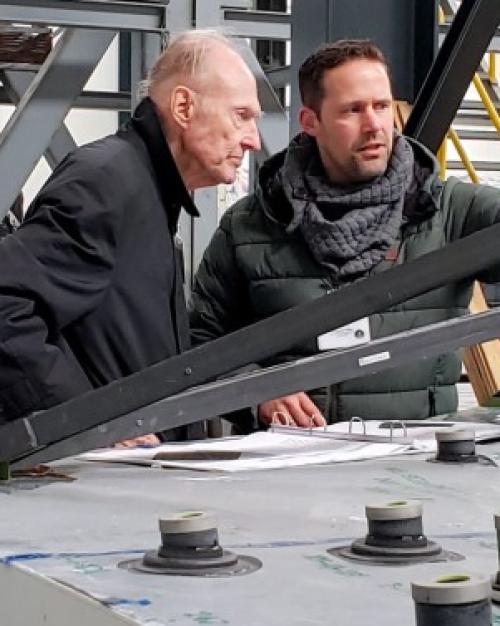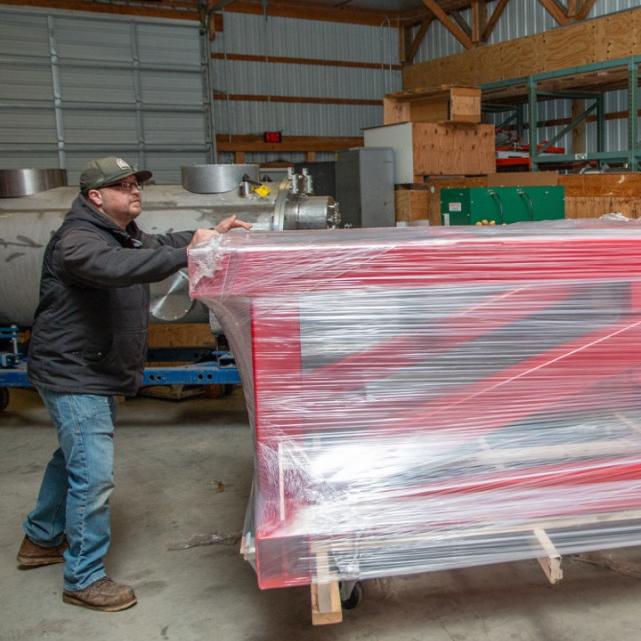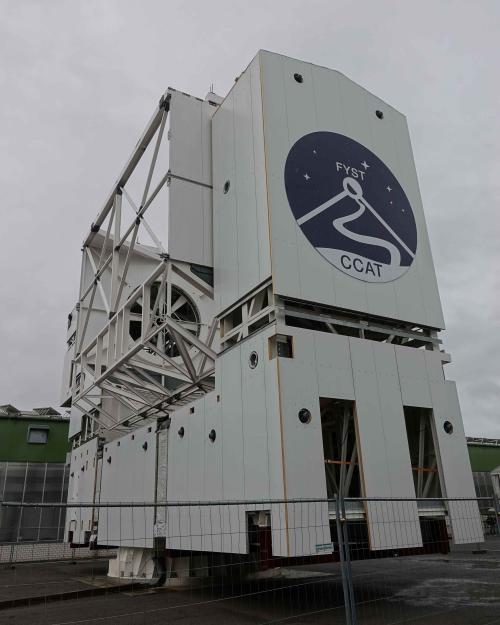The newly assembled Fred Young Submillimeter Telescope (FYST), nearly the size of a five-story building, was unveiled April 4 at an event in Xanten, Germany, attended by numerous German municipal officials – as well as Fred Young, himself.
“It is especially pleasing to participate in what is a celebration of the result of 20-some years of involvement in the creation of this significant astronomical instrument,” said Young ’64, M.Eng. ’66, MBA ’66, who has been a major champion and benefactor of FYST since the project began.
“CCAT (Cerro Chajnantor Atacama Telescope) was a vision conjured early in this century by several persons, including the late Cornell professor Riccardo Giovanelli, who recruited me to financially support the project during our several trips to Chile together,” Young said. “Our product, now called the ‘Fred Young Submillimeter Telescope,’ will stand as testimony to the quality of that vision.”
The FYST is a state-of-the-art telescope whose mirror diameter alone measures 6 meters. Designed for operation in the submillimeter to millimeter wavelength range, it will provide insights into the birth of the first stars after the Big Bang as well as the formation of newer stars and galaxies.
The telescope’s nearly completed look is only temporary, as attendees at the event were told: The FYST will soon be disassembled into 12 large pieces and transported over land and sea to the Atacama Astronomical Park, in the desert climate of the high Andes mountains of Chile.
There it will be trucked up to an elevation of 18,400 feet near the summit of Cerro Chajnantor, where it will be the second-highest telescope in the world. The highest telescope in the world is just 50 meters beyond it at the summit of the mountain.
“We at Cornell have been dreaming about building a telescope on Cerro Chajnantor for almost 30 years. For me, climbing on this telescope and watching it move and tilt is incredibly emotional,” said Martha Haynes, chair of the CCAT Board of Directors and Distinguished Professor of Arts & Sciences in Astronomy in the College of Arts and Sciences. “The best part is that there are so many young scientists who are chomping at the bit to use it to trace how the universe has developed its structure from the hot dense soup of particles at the earliest times to the superclusters, galaxies, stars and planets we see today. We won’t answer all the questions, but FYST will contribute its own special insights to our understanding of the universe.”
Partners in the project are: Cornell; a German consortium consisting of the University of Cologne, the University of Bonn and the Max Planck Institute for Astrophysics in Garching; and a Canadian consortium of several universities. The telescope was designed by CPI Vertex Antennentechnik in Duisburg and assembled in Xanten on the Wessel GmbH premises.
The transport will be orchestrated by Vertex and is expected to take four months or longer. “The logistics of moving such big parts are not at all simple; it’s a major, major movement,” said Jim Blair, FYST project manager (A&S).
In addition to previewing the massive undertaking of disassembly and transport, attendees at the April 4 unveiling heard lectures on the scientific and technical background of the telescope and its innovative design, as well as a movement demonstration and guided tours.
“The novel optical design will provide high-throughput imaging with a wide field of view, enabling rapid and efficient mapping of the entire Southern Hemisphere sky,” said Dominik Riechers from the Institute for Astrophysics at the University of Cologne, who hosted the event. “We are trying to do nothing less than better understand the creation and development of our universe since the Big Bang.”
Linda B. Glaser is news and media relations manager for the College of Arts and Sciences.







